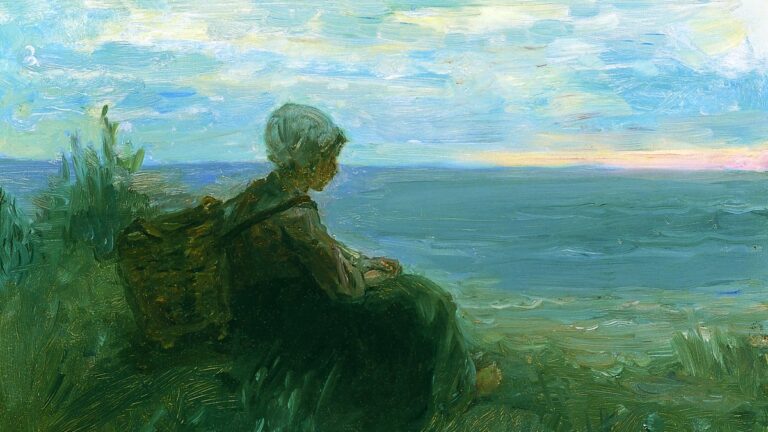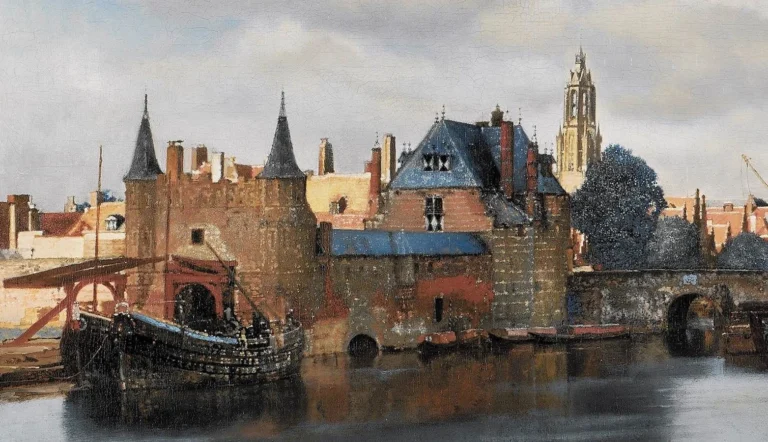Albert Bierstadt Painter: The Masterful Artist of American Landscapes
Born: January 7, 1830, Solingen, Rhine Province, Prussia
Death: February 18, 1902, New York City, U.S.
Art Movement: Hudson River School
Nationality: American
Institution: Düsseldorf School of painting
Albert Bierstadt Painter: The Masterful Artist of American Landscapes
Life and Career of Albert Bierstadt
Albert Bierstadt rose from humble beginnings to become one of America’s most celebrated landscape painters of the 19th century. His journey took him from Germany to the American West, where he created monumental paintings that captured the nation’s untamed wilderness.
Early Life and Education
Albert Bierstadt was born in Solingen, Germany on January 7, 1830. His family immigrated to the United States when he was just two years old, settling in New Bedford, Massachusetts.
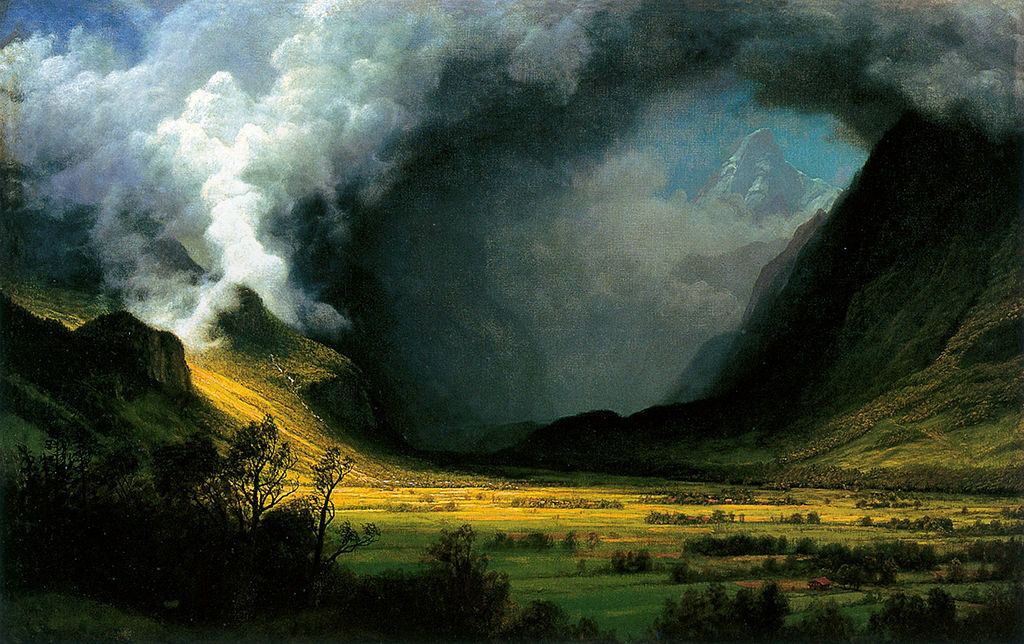
A Storm in the Rocky Mountains, Mt. Rosalie, 1866, by Albert Bierstadt
As a young man, Bierstadt showed natural artistic talent but received little formal training in America. At age 23, he returned to Europe to study painting properly.
In Düsseldorf, Germany, he trained under notable landscape painters between 1853 and 1857. This education proved crucial, as he learned the detailed, dramatic style that would later define his work.
During this time, he also traveled through Italy and Switzerland, sketching Alpine scenes that influenced his later depictions of American mountains.
Development as an Artist
Bierstadt returned to America in 1857 and quickly established himself in New York’s art scene. He joined a government survey expedition to the American West in 1859, which changed the course of his career.
This journey provided Bierstadt with his first views of the Rocky Mountains and the vast western landscapes. He filled sketchbooks with detailed drawings that would become reference material for future studio paintings.
His breakthrough came with massive canvases like “The Rocky Mountains, Lander’s Peak” (1863), which brought him national fame. These grand-scale works featured dramatic lighting, majestic mountains, and idealized wilderness scenes.
Bierstadt’s technical skill was remarkable. He combined precise details with atmospheric effects to create paintings that appeared almost photographic while remaining romantic and dramatic.
Westward Expansion Influence
Bierstadt made several more trips west between 1863 and 1873. He traveled to the California coast, Yosemite Valley, and the Sierra Nevada mountains, creating some of his most famous works.

Among the Sierra Nevada, California, 1868, by Albert Bierstadt
His paintings captured the American frontier at a pivotal time of westward expansion. Works like “Among the Sierra Nevada, California” (1868) presented the West as a magnificent, unspoiled Eden.
These images helped shape America’s national identity. They promoted the concept of “Manifest Destiny” by portraying the West as a promised land waiting to be settled.
Bierstadt became incredibly successful during this period. His paintings sold for unprecedented sums, sometimes fetching $25,000—equivalent to over $500,000 today. He built a lavish mansion on the Hudson River and achieved international recognition.
Later Years and Death
By the 1880s, public taste began shifting away from Bierstadt’s romantic style toward more modern approaches. The rise of Impressionism and changing artistic trends diminished his popularity.
Financial problems mounted after a fire destroyed his studio in 1882. Many of his paintings and sketches were lost in this disaster, dealing a severe blow to his career.
Personal tragedy also struck when his wife Louise died in 1893. Despite these setbacks, Bierstadt continued painting, though with less commercial success.
He died largely forgotten on February 18, 1902, in New York City at age 72. Interest in his work revived decades later, and today his paintings hang in major museums and command millions at auction. His legacy as one of America’s greatest landscape painters is now firmly established.
Artistic Style and Techniques
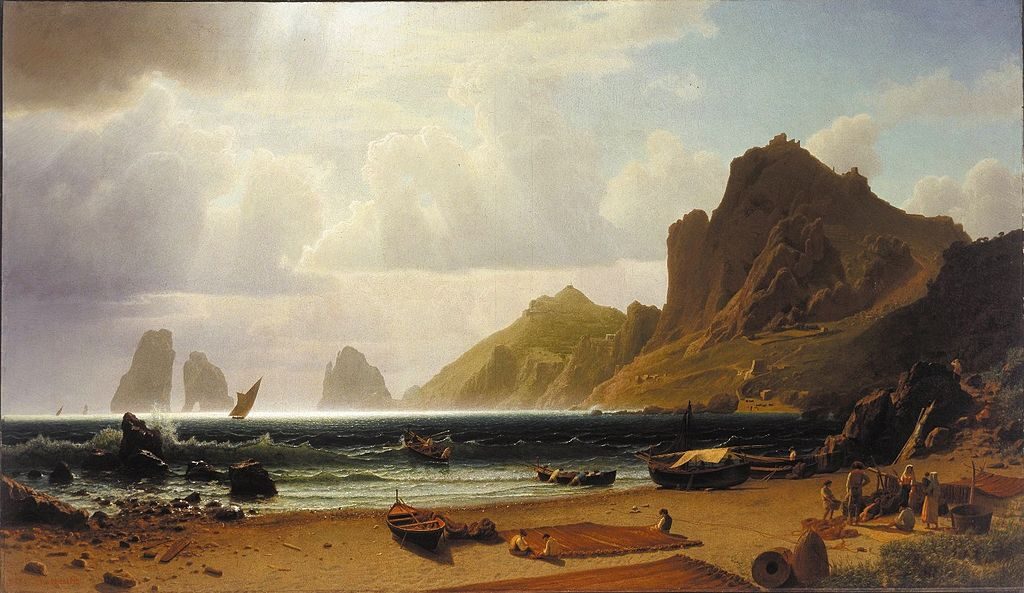
The Marina Piccola, Capri, 1859, by Albert Bierstadt
Albert Bierstadt developed a distinctive painting style that captured the grandeur of American landscapes with remarkable technical skill. His approach combined European training with a uniquely American sensibility, creating works that became iconic representations of the American West.
Influence of the Düsseldorf School
Bierstadt’s formal training at the Düsseldorf Academy in Germany profoundly shaped his artistic technique. The Düsseldorf School emphasized precise draftsmanship, careful attention to detail, and meticulous studio work.
Students learned to create highly finished paintings with smooth brushwork that concealed individual strokes. This training gave Bierstadt the technical foundation to render landscapes with extraordinary precision.
He applied these German techniques to American subjects, creating a unique fusion of European methodology and American themes. The dramatic compositions and theatrical lighting taught at Düsseldorf became hallmarks of his work.
Luminism and Detail
Bierstadt incorporated elements of Luminism, a distinctly American style characterized by the effects of light on landscape and detailed realism. His paintings feature incredibly precise details, from individual leaves to subtle reflections on water surfaces.
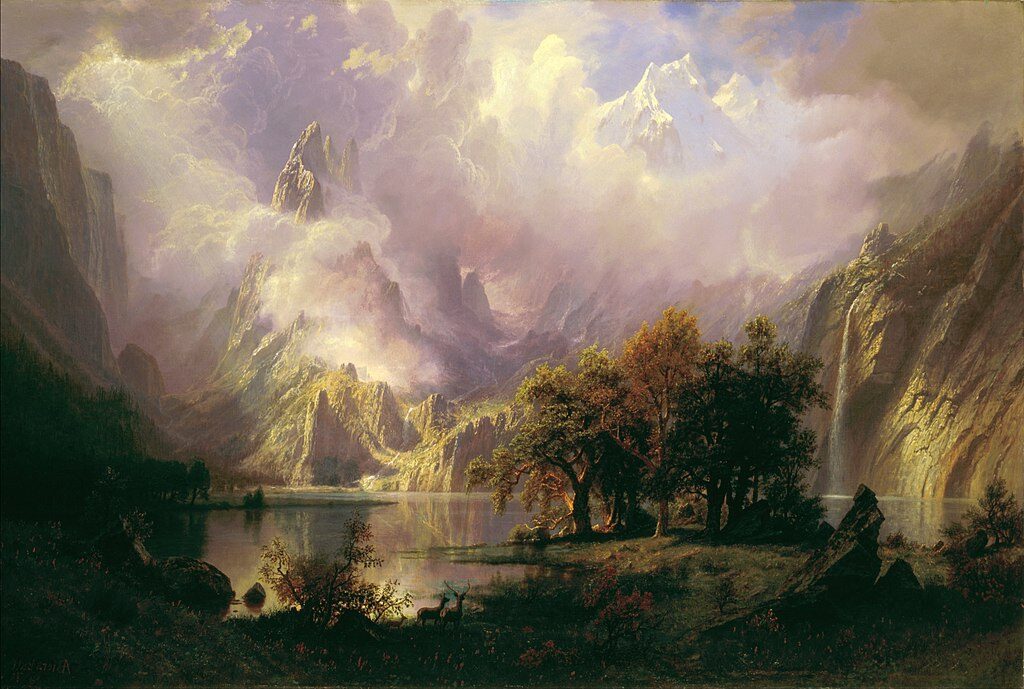
Rocky Mountain Landscape, 1870, by Albert Bierstadt
He often painted with a small brush, layering transparent glazes to achieve remarkable depth and luminosity. This technique allowed him to capture the way light filters through clouds or reflects off mountain lakes with stunning realism.
Even in massive canvases, Bierstadt maintained precise details throughout. Viewers can examine his works closely and discover miniature elements—tiny animals, people, or plants—rendered with perfect clarity.
Use of Light and Color
Light became Bierstadt’s signature element. He mastered the ability to depict dramatic lighting effects, particularly the golden glow of sunrise or sunset that bathes landscapes in warm radiance.
His color palette shifted from the muted tones popular in European landscape painting to more vibrant hues that captured the unique quality of light in the American West. He used contrasting colors to create depth and drama.
Bierstadt’s skies often feature dramatic clouds and atmospheric effects. He employed subtle transitions from warm to cool colors to suggest vast distances and create a sense of atmospheric perspective.
Composition and Subject Matter
Bierstadt favored dramatic, panoramic compositions that emphasized the monumental scale of American landscapes. He typically structured his paintings with dark foregrounds framing distant, illuminated vistas.

Gosnold at Cuttyhunk, c. 1858, by Albert Bierstadt
His subject matter focused on untamed wilderness, particularly mountains, lakes, and valleys. The Rocky Mountains and Yosemite Valley became recurring themes in his most celebrated works.
Bierstadt often included small human figures or Native Americans to emphasize the overwhelming scale of nature. This compositional choice communicated his central message: the sublime power and divine beauty of America’s natural landscapes.
Legacy and Collections
Albert Bierstadt’s impact on American art has been significant and long-lasting. His dramatic landscapes helped shape how Americans viewed their country and influenced generations of artists who followed.
Contribution to American Art
Bierstadt played a crucial role in the Hudson River School movement, bringing attention to America’s spectacular western landscapes. His paintings created a visual identity for the nation during its westward expansion. Through his work, he promoted the concept of “Manifest Destiny” and helped Americans see their land as something grand and majestic.
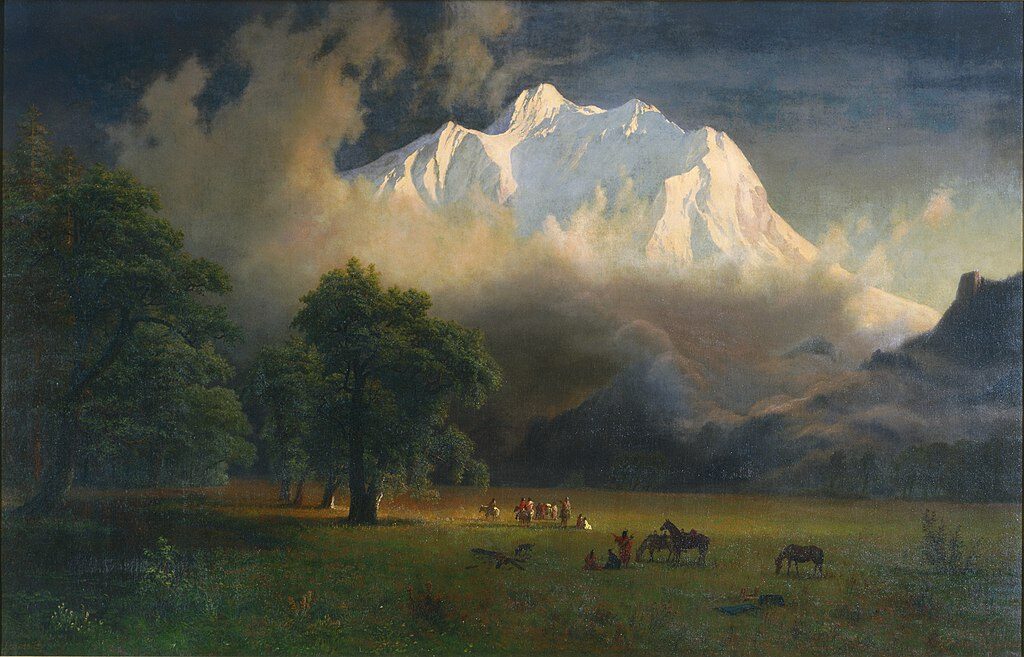
Mount Adams, Washington, 1875, by Albert Bierstadt
His technical innovations in light and atmospheric effects influenced many landscape painters who came after him. Bierstadt’s approach to monumentality—creating grand, sweeping vistas—established a distinctive American artistic style.
Though his reputation declined in his later years, art historians now recognize his importance in documenting the American wilderness before extensive development.
Major Works and Exhibitions
Bierstadt’s most celebrated paintings include “Among the Sierra Nevada, California” (1868), “The Rocky Mountains, Lander’s Peak” (1863), and “Storm in the Rocky Mountains, Mt. Rosalie” (1866). These works exemplify his signature style of dramatic lighting and awe-inspiring scale.
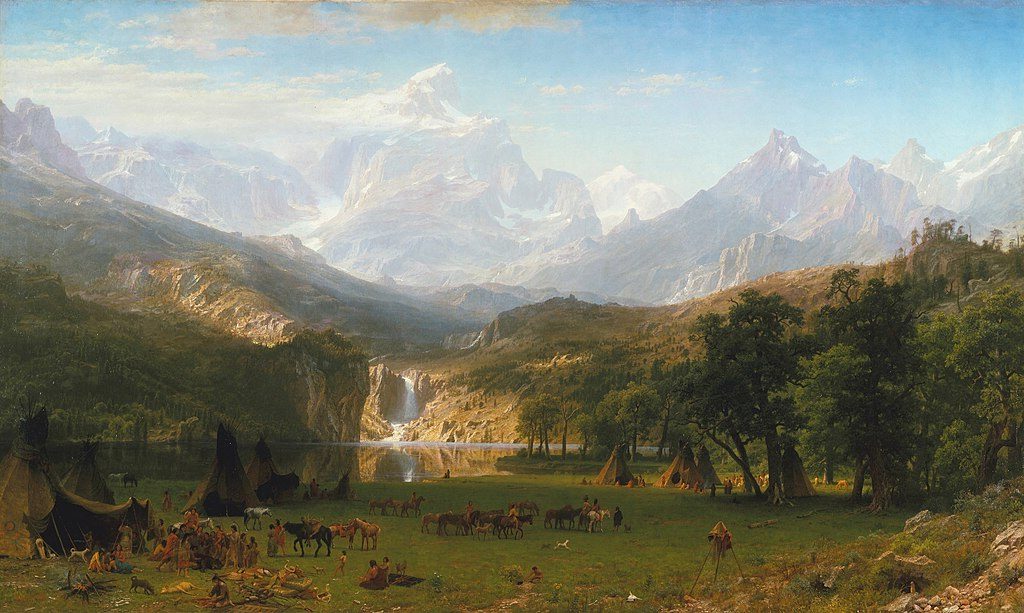
The Rocky Mountains, Lander’s Peak, 1863, by Albert Bierstadt
During his lifetime, Bierstadt’s work appeared in prestigious venues including the National Academy of Design and the Paris International Exposition. His solo exhibitions drew large crowds and significant press coverage.
His panoramic paintings often traveled as special exhibitions, charging admission for viewers to experience their grandeur. These touring shows helped make Bierstadt one of the most famous American artists of his time.
Bierstadt’s Works in Museums
Bierstadt’s paintings are housed in major institutions worldwide, with significant collections in:
| Museum | Notable Bierstadt Works |
|---|---|
| Metropolitan Museum of Art | “The Rocky Mountains, Lander’s Peak” |
| National Gallery of Art | “Among the Sierra Nevada, California” |
| Smithsonian American Art Museum | “The Last of the Buffalo” |
| Buffalo Bill Center of the West | Multiple Yellowstone paintings |
Several of his works have been featured on U.S. postage stamps, further cementing his cultural significance. Smaller regional museums, particularly in western states, often display his works to highlight local landscapes.
The Art Market and Bierstadt Today
Bierstadt’s paintings command impressive prices at auction, with major works selling for millions of dollars. In 2008, his painting “Valley of the Yosemite” sold for over $7 million, demonstrating his enduring market value.

Valley of the Yosemite, 1864, by Albert Bierstadt
Contemporary exhibitions of his work often focus on environmental themes, connecting his romantic visions to modern conservation efforts. His paintings serve as historical records of landscapes that have since been altered by development.
Art historians continue to study Bierstadt’s techniques and his role in shaping American identity. Recent scholarship has explored how his work influenced national park creation and early tourism in the American West.
Digital archives and high-resolution photography now allow wider access to his work, introducing new generations to his dramatic landscapes.
Frequently Asked Questions
Albert Bierstadt created stunning landscape paintings that captured America’s natural beauty during the 19th century. His distinctive style and contributions to American art continue to inspire interest and admiration today.
What artistic movement is Albert Bierstadt best associated with?
Albert Bierstadt is best associated with the Hudson River School art movement. This 19th-century American art movement focused on romantic, detailed landscape paintings.
Bierstadt became one of the most prominent second-generation painters in this movement. His work exemplified the grand, sweeping vistas and luminous qualities that defined Hudson River School aesthetics.
He also incorporated elements of German Romanticism in his paintings, reflecting his training in Düsseldorf, Germany.
How did Albert Bierstadt contribute to the depiction of the American West?
Bierstadt’s journeys throughout the American West resulted in majestic paintings that introduced many Americans to these landscapes for the first time. His works showed the grandeur of places like Yosemite Valley and the Rocky Mountains.
These paintings helped shape the American perception of the frontier as a place of natural wonder and divine beauty. Through his art, Bierstadt promoted the concept of “Manifest Destiny” and the romantic idea of westward expansion.
His dramatic, idealized scenes influenced tourism and conservation efforts in the American West.
What are some of Albert Bierstadt’s most famous works?
“Among the Sierra Nevada Mountains, California” (1868) stands as one of Bierstadt’s masterpieces, displaying his skill with light and atmospheric effects. “The Rocky Mountains, Lander’s Peak” (1863) became instantly famous and sold for the remarkable sum of $25,000.
“Storm in the Rocky Mountains – Mount Rosalie” (1866) showcases his talent for dramatic weather scenes. “Yosemite Valley” (1868) captures the magnificent scale and beauty of this iconic location.
“The Last of the Buffalo” (1888) represents a departure from pure landscape, incorporating wildlife and addressing the disappearing frontier.
Can you describe the characteristics of Albert Bierstadt’s painting style?
Bierstadt’s style featured dramatic lighting effects often called “luminism.” He used a technique of glowing light and atmospheric haze to create almost mystical scenes.
His paintings typically contained meticulous detail in the foreground that gradually softened into the distance. Bierstadt employed large canvases to convey the overwhelming scale of American landscapes.
Rich colors, strong contrasts between light and shadow, and careful composition were hallmarks of his work. He often enhanced natural features to increase drama, making mountains taller or valleys deeper than reality.
What influence did Albert Bierstadt have on future generations of artists?
Bierstadt’s dramatic approach to landscape painting influenced numerous later artists working in the American West. His techniques for capturing light and atmosphere can be seen in the works of painters like Thomas Moran and Frederic Church.
His romanticized vision of nature helped establish a distinctly American artistic identity. Photography of western landscapes, including the work of Ansel Adams, echoes Bierstadt’s sense of scale and majesty.
Modern environmental art movements often reference Bierstadt’s work when highlighting the importance of preserving natural landscapes.
Where can one view Albert Bierstadt’s original paintings today?
The Metropolitan Museum of Art in New York houses several important Bierstadt works, including “The Rocky Mountains, Lander’s Peak.”
The National Gallery of Art in Washington, DC maintains a significant collection of his paintings.
The Smithsonian American Art Museum displays “Among the Sierra Nevada Mountains, California.” Many regional museums throughout the United States, particularly in the West, feature his work.
The New-York Historical Society, the Museum of Fine Arts in Boston, and the Denver Art Museum also contain notable Bierstadt paintings. Some of his works occasionally travel as part of special exhibitions focused on American landscape painting.



